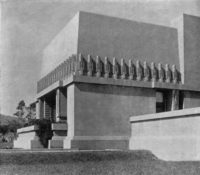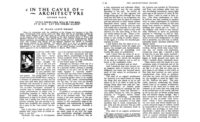By the “life” in the thing I mean the integrity of the thing (we are talking of the things of art and craft) in the sense of the third dimension – as I have already tried to explain it.
The “life” in the thing is that quality of it or in it which makes it perfectly natural – of course that means organic. And that simply means true to what made it, as it was made, and for what it was made. That would be the body of the “thing.” A matter of good sense.
New opportunities have come, not to hand but to the mind.
This may not seem specific. But it is a point of view necessary to the understanding of the experiences which follow. For in that spirit the experiments were made and the results judged as good or bad that will appear as I write.
The first study of importance in this connection is of course, the nature of materials.
It is impossible to do anything intelligently to or with something you know nothing about. To know intimately the nature of wood, paper, glass, sheet metal, terra cotta, cement, steel, cast iron, wrought iron, concrete, is essential to knowing how to use the tools available to make use of those materials, sensibly or artfully.
So let us glance at these more staple materials. We will find certain properties in all, that standardization will serve well; and other properties, too, that standardization, carried too far, will kill.
The principle of standardization, applied, may be said to be a matter of knowing by a study of the nature of whatever we apply it to – when to quit.
Let us being with a short study of wood.
What is wood?
A workable, fibrous material got from trees in almost any length, certain breadths and thicknesses, now standardized. It may be had in almost any color or texture, as trees are growing in great variety all over the world. Different woods vary in characteristics, made known by use in all ages. To it man has had recourse for nearly every need. He has made of it a part, or entirely, in one form or another, nearly everything he uses. It may be polished, or painted, or stained, to bring out its grain which is the great characteristic of its beauty. It may be sawed or cut to bring this beauty to the surface in various ways. It was once laborious to hand-saw and cut and smooth it. Machines now do all that better. Machines cut veneers so cheaply and so thin and so wide they may be applied like wall paper to broad surfaces. Machines cut rotary veneers from the curling surface of a log in any width, unwinding the surfaces with a cut of the grain unknown before. Really, this property of wood has been liberated and made available in beautiful sheets, so beautiful in surface that it is folly to mold it, and join it, and panel it painfully any more as before.
It may be used in broad simple plastic ways now even more cheaply than in laborious joinery with its tendency to go to pieces because it was all in pieces.
Much more could be said. Here is enough to indicate new possibilities of design in machined wood.
Inlaid lines are characteristic too, - slender inlaid decorative purflings or battens between wide, plain, broad, etc., etc.
Plastictreatment, now, you see, instead of constructed ones or “structuralities.”
There are infinite possibilities here. And in making wood into furniture, clean straightline effects, as delicate as may be, are characteristic of the machine. A limitation that makes the nature of wood very beautiful as it appears within these limitations of form.
Wood carving usually did violence to the nature of wood. It tended to mutilate and destroy it.
The machine can inlay, fret and bring up the beauty of wood in plastic treatments more true to the nature of the wood. Why not then, forget ancient models that are especially made to suit freedom of the hand” the nature of wood was overwrought and lost in three out of five such models anyway. But here the beauty that is wood lives above standardization, if the architect sees it and uses it in this new “plastic” sense.
Let us take glass.
Glass was once a delightful substance in itself. It is now chiefly a perfect “clarity” or nothing very delightful.
Such clearness in polished glass as we have is new in the world. We may have great polished surfaces for reflections, leaving openings as though nothing closed them – limpid surfaces playing the same part in all interiors that water plays in the landscape. We have lost a substance but found a freedom indefinitely precious to the designer of buildings. This is the mechanical plate glass of the machine. New opportunities here. Imagine a few.
There is electro glazing to introduce the element of pattern into the clear glass in delicate straight lines in bewildering delicacy and variety.
The mind must enter now to take the place of what, in the antique, was adorable as a natural quality of glass itself. The scene has shifted, but we are still better off, in glass.
We can make colored glass for the painter to use as pigment in his hand, but it is now a lesser interest. We have limpid surfaces, true reflections and unobstructed vision due to the machine.
And there is steel*. A new thing under the sun. And the most significant material of this age. The one that has done most harm to the established order – or Pseudo-Classic.







